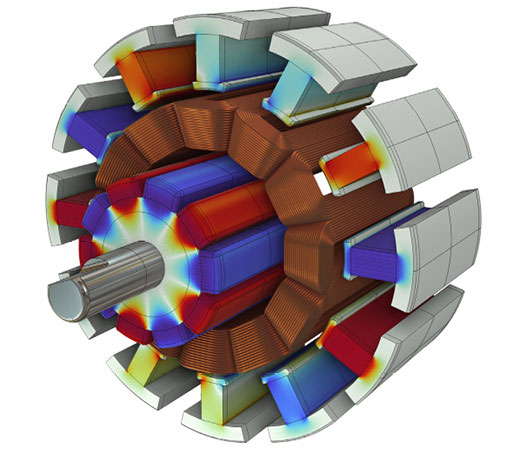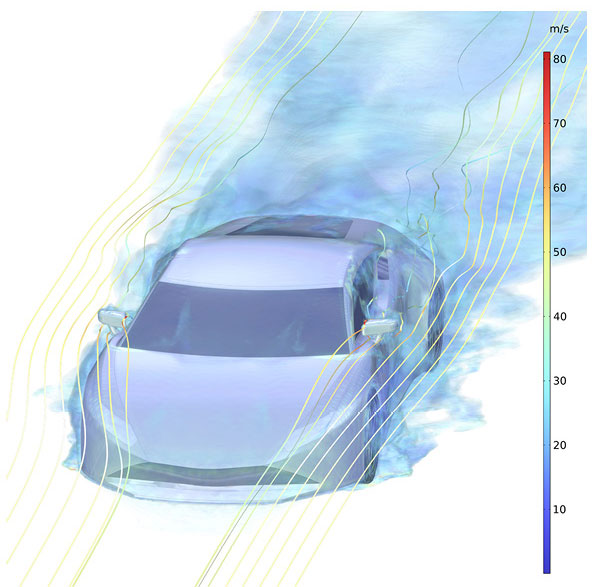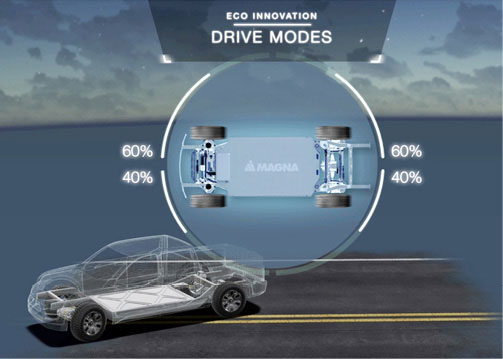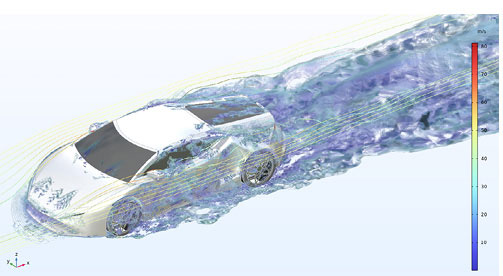Visual Effects
Engineering software is effective as a visual tool to help drive product sales, demonstrations and content creation for marketers.

A good visualization of simulation data requires some artistic judgment from the person creating the visualization in much the same way that a well-taken photo needs to be well structured, with the right type of lighting and perspective. Image courtesy of COMSOL.
Latest News
November 1, 2021
Software tools help engineers create design visualizations to communicate products (such as automobiles) in lifelike scenarios, for entertainment purposes as well as for other communications such as sales presentations and product demonstrations.
“There is now a massive suite of software that enables artists to visualize products that are either not yet built or manufactured,” says William O’Donnel who leads the digital twin division at The Moving Picture Company in New York City. “These 3D assets that artists are creating for brands—often referred to as digital twins, are now used on a growing number marketing and commerce platforms as well as traditional legacy mediums like print and billboards.”
According to O’Donnel, the automotive space is mature for the CAD and digital twin user. “All car companies have a website that features a configurator that allows customers to configure a car,” he says.
O’Donnel points to Mercedes-Benz, who allows shoppers to view different options and virtually “build” their own vehicle (bit.ly/3mtlyWf).
“Over the last five years, automotive brands and their agencies have found many other uses for these 3D assets: extended reality, virtual reality [VR], augmented reality [AR] and mixed reality [MR] animations for social media, showroom retail kiosks, pack shots for broadcast or print and training for mechanics and support staff,” he explains. “Simulation and training are a massively growing area for industry, as is the health sciences.
“Digital twins of consumer package goods and beauty products are quickly maturing, in part because COVID-19 disrupted the traditional product photo shoot,” O’Donnel continues. “These verticals are understanding the use case for the digital twin asset goes beyond the product description page on a marketplace, but also promises a continuity to their product imagery by more easily maintaining lighting and camera angles for products, all without needing a photo shoot.”
Data Visualization is Widely Adopted
Richard Kerris is the vice president for Omniverse Development Platform at NVIDIA. NVIDIA Omniverse is built for real-time simulation and collaboration and uses existing software tools that can connect to the platform and extend and enhance existing workflows with these new capabilities. What previously took hours to render and was targeted for visual effects and game development is now used in manufacturing, architecture and scientific visualization.
“3D visualization has become the standard across many industries, from architecture and design to visual effects and games,” says Kerris. “The challenge these industries are tackling is how to show objects in real-world environments and true-to-reality simulations. For example, how do you show a car designed and rendered in 3D that can be configured and changed in real time in order to present design configurations for customers?
“Up until the breakthrough of real-time ray tracing, which NVIDIA pioneered with our RTX technology, the idea of interacting with the photorealistic designs was only a dream,” Kerris adds. “That dream has now become a reality. We’re seeing real-time photorealistic 3D designs being used across many industries where visualization is key.”
Phil Kinnane is the senior vice president of sales for COMSOL in Burlington, MA. He explains that their multiphysics software tools are used for modeling and simulation in various physics areas, such as electromagnetics, structural analysis, acoustics, fluid flow, heat transfer and chemical engineering.

Multiphysics simulations are useful in presentations in designs or manufactured products because they can illuminate aspects of the design, or simulation, that are otherwise invisible. Image courtesy of COMSOL.
“Visualizations resulting from COMSOL Multiphysics simulations are useful in presentations in designs or manufactured products because they can illuminate aspects of the design, or its simulation, that are otherwise invisible,” says Kinnane. “A classic example of this is the mechanical stress distribution inside of a manufactured part or the flow over an airplane wing or car.
Kinnane cites other examples: the acoustic radiation field outside of a speaker, the electromagnetic field inside of a microwave oven or the temperature distribution in an electric motor. Though these are not visible to the naked eye, they all have meaning when visualized, according to Kinnane.
“The post-processing of simulation data concerns mostly calculating numerical values or data that can be used to quantify different aspects of a design and point toward different data-based conclusions, such as an optimized version of this design,” Kinnane says. “Yet, in order to provide intuitive first impressions, context to the design or application at hand, or demonstration to those not familiar with understanding the numerical data, the visualization of simulation data is often an imperative part of the overall design workflow.”
The Transformative Power of Visualization Products
“It’s all about using existing product data from engineering by leveraging the CAD data and transforming them into high-quality product content—from basic 2D images to 3D glTFs, WebGL, videos, interactive product showcase experiences or 3D sales configurators,” says Martina von der Wense, senior strategic planner for Dassault Systèmes, 3DEXCITE.

She highlights Dassault’s 3DEXPERIENCE platform as providing connected and integrated marketing and sales solutions for 3D product content and experience creation from a secure cloud environment.
“Engineers, designers, 3D creatives, experience builders and makers alike can easily create up-to-date product content,” says von der Wense. “They will use it for internal product reviews, direct sales engagements with the end-customers, virtual events, any product marketing campaigns, product catalogues, 3D sales configurators, AR and VR experiences, social media channels, e-commerce and any other use case where it’s about product communication and showcasing the products’ values and features.
“The common foundation for a solid and fast product content production for engineers, designers, 3D creatives or marketers is a digital twin,” von der Wense says.
von der Wense also explains that digital twins usually contain too much information to create product visualizations for product communication. They need to become lighter and be optimized.
The “Commercial Twin Creation” tool set allows an integrated way to complete and optimize the latest twin by simplifying the engineering data (removing all the information not needed for commercial and marketing visualizations) and enriching the twin with relevant product information such as material and colors.
“This customer-centric product twin, or the ‘commercial twin,’ sets the baseline for an IP-protected and product correct 3D content production,” she says. This helps ensure content consistency, compliance and reflects the latest product changes from engineering during production across the entire product portfolio, according to von der Wense.
She further explains that the automated work steps and the “single source of truth” approach compress the time to market by starting product content production in parallel to the product design process. Additionally, users can work with reusable content from external sources as well as libraries of products, ambiences and materials to ensure a consistent and efficient process.
Design visualization tools have many use cases. Neset Yalcinkaya is the vice president of products and general manager for R&D for Quectel, a global supplier of cellular and global navigation satellite system modules for wireless technologies like 5G that are now at the forefront of mobile cellular technology.
Yalcinkaya touts the benefit of digital twins as data visualization tools for their industry, and explains that the essential performance component at the heart of any digital twin deployment is connectivity that can reliably connect digital twins to physical objects and ensure huge volumes of data that are captured in real time can be communicated.
“The connectivity is essential to ensure continuously updated records, so the physical twin and the digital twin or twins have the same data and remain aligned with each other. Inevitably this highly frequent communication, which often involves transmission of large amounts of data, relies on robust, low latency [and] high bandwidth connectivity,” says Yalcinkaya. “2G and 3G cellular networks are therefore inadequate for many digital twin deployments because they provide neither the speed nor the low latency that such deployments demand. However, LTE [long-term evolution, a wireless standard] is applicable to some less latency-sensitive digital twin applications and 5G addresses all latency concerns with its sub-1 ms latency performance.”
There are additional performance challenges to consider with LTE, according to Yalcinkaya, because digital twin applications that use rapid prediction followed by action need high-speed data processing capabilities. LTE cannot always support this, which means higher 5G speeds are required.
Economics of Data Visualization Tools
O’Donnel is bullish on digital twin solutions as an economical, effective tool to aid marketers now and in the future. He says that most chief marketing officers and their agencies are having to manage an ever-increasing number of consumer touch points while the marketing budgets are not moving at the same rate.

Brands are pushing back on the agency fees for content creation forcing a digital twin solution that includes repurposing these digital assets in lieu of traditional content creation. O’Donnel also notes that COVID-19 accelerated this innovation.
“Digital twins provide an answer for a good number of the emerging digital platforms like social media, and augmented reality,” O’Donnel says. “But the challenge is then the adoption internally by brands and evangelizing the efficiencies and spreading that change through the marketing and commerce funnel.”
There are real efficiencies to be gained by brands but only through wholesale adoption, not piecemeal, according to O’Donnel. “These are incredibly exciting times as we emerge from COVID-19, and to a new world of consumer behavior that is giving brands the opportunity and freedom to be innovative in the face of this change,” he says.
More COMSOL Coverage
More Dassault Systemes Coverage

More NVIDIA Coverage
Subscribe to our FREE magazine, FREE email newsletters or both!
Latest News
About the Author
Jim Romeo is a freelance writer based in Chesapeake, VA. Send e-mail about this article to [email protected].
Follow DE






